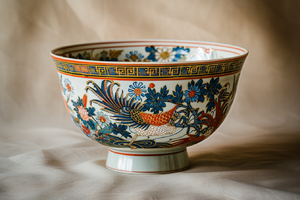Ko-Imari/en: Difference between revisions
Updating to match new version of source page |
Updating to match new version of source page |
||
| Line 2: | Line 2: | ||
<languages /> | <languages /> | ||
[[File:Ko-Imari.png|thumb|Ko-Imari ware from the Edo period]] | |||
'''Ko-Imari''' (literally ''Old Imari'') refers to the earliest and most iconic style of Japanese Imari ware produced primarily during the 17th century. These porcelains were made in the town of Arita and exported from the nearby port of Imari, which gave the ware its name. Ko-Imari is especially notable for its dynamic decorative style and historical significance in early global porcelain trade. | '''Ko-Imari''' (literally ''Old Imari'') refers to the earliest and most iconic style of Japanese Imari ware produced primarily during the 17th century. These porcelains were made in the town of Arita and exported from the nearby port of Imari, which gave the ware its name. Ko-Imari is especially notable for its dynamic decorative style and historical significance in early global porcelain trade. | ||
Latest revision as of 05:11, 17 July 2025
Ko-Imari

Ko-Imari (literally Old Imari) refers to the earliest and most iconic style of Japanese Imari ware produced primarily during the 17th century. These porcelains were made in the town of Arita and exported from the nearby port of Imari, which gave the ware its name. Ko-Imari is especially notable for its dynamic decorative style and historical significance in early global porcelain trade.
Historical Background
Ko-Imari ware emerged in the early Edo period, around the 1640s, following the discovery of porcelain clay in the Arita region. Influenced initially by Chinese blue-and-white porcelain, local Japanese potters began to develop their own stylistic identity. As China’s porcelain exports declined due to the fall of the Ming Dynasty, Japanese porcelain began filling the gap in international markets, particularly through trade with the Dutch East India Company.
Key Features
The distinctive qualities of Ko-Imari include:
- Bold and colorful designs, typically combining cobalt blue underglaze with overglaze enamels in red, green, and gold.
- Dense and symmetrical decoration covering nearly the entire surface, often described as richly ornate or even opulent.
- Motifs such as chrysanthemums, peonies, phoenixes, dragons, and stylized waves or clouds.
- Thick porcelain body compared to later, more refined pieces.
Ko-Imari ware was not intended solely for domestic use. Many pieces were tailored to suit European tastes, which included large plates, vases, and garnitures for display.
Export and European Reception
Ko-Imari ware was exported in large quantities throughout the 17th and early 18th centuries. It became a fashionable luxury item among European elites. In palaces and aristocratic homes across Europe, Ko-Imari porcelain adorned mantelpieces, cabinets, and tables. European porcelain manufacturers, particularly in Meissen and Chantilly, began producing their own versions inspired by Ko-Imari designs.
Evolution and Transition
By the early 18th century, the style of Imari ware began to evolve. Japanese potters developed more refined techniques, and new styles such as Nabeshima ware emerged, focusing on elegance and restraint. The term Ko-Imari is now used to specifically distinguish these early exported works from later domestic or revival pieces.
Legacy
Ko-Imari remains highly valued by collectors and museums worldwide. It is considered a symbol of Japan’s early contribution to global ceramics and a masterwork of Edo-period craftsmanship. The vivid designs and technical achievements of Ko-Imari continue to inspire both traditional and contemporary Japanese ceramic artists.
Relationship to Imari Ware
While all Ko-Imari ware is part of the broader category of Imari ware, not all Imari ware is considered Ko-Imari. The distinction lies primarily in the age, style, and purpose. Ko-Imari specifically refers to the earliest period, characterized by its dynamic energy, export orientation, and richly decorated surfaces.
